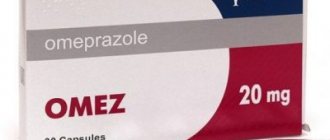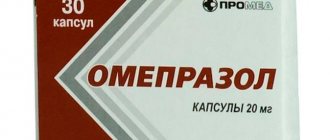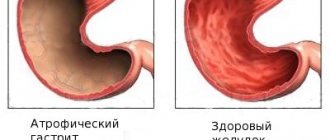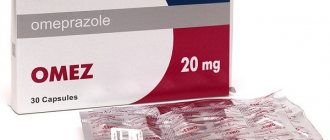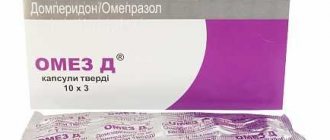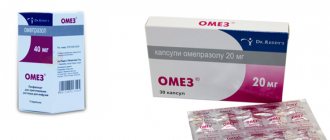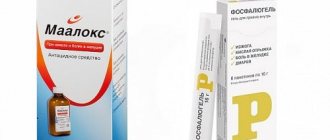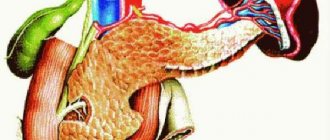Chronic gastritis, gastric or duodenal ulcers are common pathologies of the gastrointestinal tract. This disease affects: the working population, the elderly, and children. There are many provoking factors. Some can be corrected, some cannot. The main reason is an increased concentration of the bacterium that causes the inflammatory process - Helicobacter pylori.
There are various treatment regimens for this disease. The main goal is to prescribe a drug that promotes effective eradication of the pathogen. One option is to prescribe de-nol. The second component of therapy has a protective effect, promotes the restoration of the mucous membrane of the digestive structures, for example, “omez”. Helps reduce the production of hydrochloric acid.
Taking Omez and De-nol together - your doctor can give recommendations
Description of the drug De-Nol
The drug belongs to the group of gastroprotectors that are used in the treatment of peptic ulcers and gastritis. Its active substance is a complex bismuth salt. The product has the following therapeutic effects:
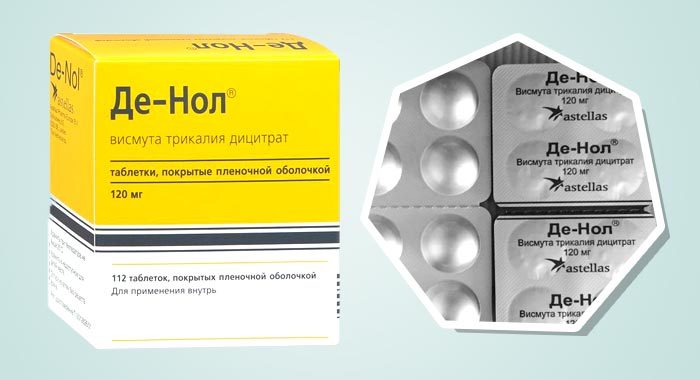
- forms a protective film on the inner walls of the stomach, which prevents the development of further lesions of the mucous membranes;
- stimulates the production of mucus (mucin), which is a natural defense against the aggressive effects of digestive juices;
- reduces acidity, reduces the negative effect of peptin, a digestive enzyme, on the stomach walls;
- improves blood supply, stimulates metabolic processes;
- suppresses the activity of Helicobacter pylori, reducing their mobility.
Thus, the effectiveness of the drug in the treatment of gastritis and ulcers is undoubted. In addition, the drug may be prescribed for the treatment of irritable bowel syndrome.
Omez for stomach ulcers
"Omez" is a medicine named after the active ingredient - omeprazole. Its main purpose is to neutralize excess hydrochloric acid contained in digestive juice. The maximum therapeutic effect develops a quarter of an hour after administration, which lasts all day.
Compound
The active ingredient of Omez is omeprazole with a concentration of 10, 20, 40 mg, which is contained in capsules or powder to obtain an injection suspension. The medicine is taken orally or infused in the form of a lyophilisate. An auxiliary component of the capsule is gelatin, which forms the shell and holds the white granules of omeprazole together.
Operating principle
“Omez” has a complex effect on the mucous membranes of the epithelium on the walls of the stomach and duodenum, which are affected by ulcers.
The main purpose of the drug is to inhibit excess secretory activity in the production of gastric acid. Due to the high effectiveness of the drug, a reduced level of acidity of the digestive juice is observed shortly after taking the capsule and lasts all day.
The antiulcer drug acts on the enzymes (H -K -ATPase) that form the proton pump of the parietal cells of the organ. Thanks to this action, most of the synthesized hydrochloric acid is blocked. The medicine does not change its effectiveness when pathology develops from any type of irritant.
In patients with ulcers, a single dose of Omez at a concentration of 20 mg allows maintaining intragastric acidity at a level of 3 units for 17 hours. Complete restoration of gastric secretory activity is achieved 3-5 days after the start of therapy.
Dosage forms
"Omez" is available in two forms:
- Capsules, dissolved by intestinal microflora, are decorated with a gelatin shell. Concentrations of the active ingredient can be 10, 20, 40 mg.
- Powder for injection, diluted with saline solution. The injection powder is supplied in vials and contains the main substance in a concentration of 40 mg.
There are three types of capsulated drug:
- "Omez D" containing omeprazole and domperidone. The action of hard white capsules with a purple lid is aimed not only at stabilizing and maintaining acidity levels, but also at enhancing intestinal motility, which improves digestion. It is produced in the form of capsules with a concentration of the active substance of 20 mg (10 mg each of omeprazole and domperidone).
- "Omez Insta" is prepared in powder form for oral suspension. It has a pleasant taste and smell. Suitable for treating children over 12 years of age.
- "Omez" with a concentration of 20 mg of omeprazole, produced in the form of transparent capsules with a pink cap. Packaged in blasters of 10 units.
Return to contents
How to take Omez when treating stomach ulcers?
Acute gastric ulcer pathology with a complication in the form of erosive-ulcerative esophagitis, affecting the deep layers of the mucous epithelium of the esophagus, is treated with 20 or 40 mg contained in 1 or 2 capsules of Omez, respectively. The drug for ulcers is taken once a day for a course of 1 to 2 months. If pathology develops while taking non-steroidal anti-inflammatory drugs, Omez is prescribed 20 mg in the amount of 1 capsule per day for a course of 1 to 2 months.
It is recommended to treat stomach ulcers caused by infection with Helicobacter with doses of the drug in the amount of 1 capsule with a concentration of the active substance of 20 mg, twice applied for a period of 1 week. Omez is taken together with antibiotics.
To prevent recurrence of ulcers, a dosage of 20 mg or 1 capsule once a day is recommended. If, against the background of a stomach ulcer, reflux esophagitis has developed, which is accompanied by the backflow of organ contents into the esophagus, the recommended dose is 20 mg per day for up to six months.
Treatment of complications of stomach ulcers in the form of a malignant pathology called Zollinger-Ellison syndrome is carried out with a loading dosage of the drug, according to the initial level of gastric secretion. 60 mg per day is immediately prescribed. If necessary, the dosage is increased to 80-120 mg, divided into two doses.
Contraindications
- Hypersensitivity to the components of Omez.
- Age up to 12 years.
- Obstruction or bleeding in the gastrointestinal tract.
- Pregnancy and breastfeeding.
- Pituitary tumors.
Under supervision, the drug is prescribed in the treatment of patients with renal or hepatic dysfunction.
Compatibility with other medications
"Omez" is compatible with all drugs prescribed for stomach ulcers, in particular with antacids. There may be a change in the ability of drugs to be absorbed, the absorption of which depends on the gastric pH value, for example, iron salts.
Sources used: tvoyzheludok.ru
Description of the drug Omeprazole
The drug belongs to the proton pump inhibitors, that is, its main purpose is to reduce the level of acidity of gastric juice. The drug helps:
- for peptic ulcers of the stomach and duodenum;
- with gastritis with increased acidity.
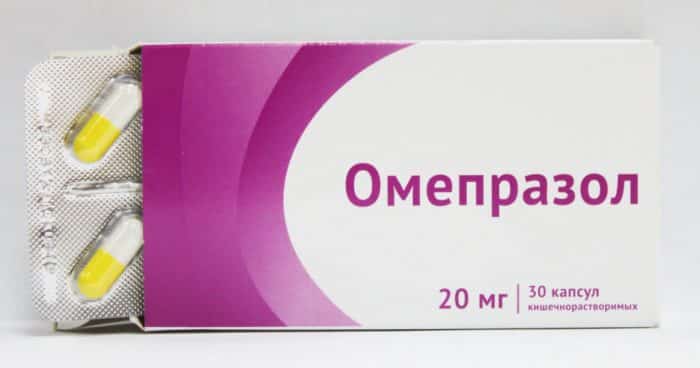
In addition, Omeprazole capsules help eliminate Helicobacter pylori infection, which is most often the main cause of the development of inflammatory diseases of the stomach.
Treatment regimen for Helicobacter pylori with antibiotics
Principles of H. pylori eradication with antibiotics
- Treatment should be preceded by an examination. All patients with abdominal pain should be tested for Helicobacter pylori. When this infection is initially detected, complex antibacterial therapy is carried out, taking into account the individual characteristics of the patient, concomitant pathology or allergic reaction to drugs. If the pathogen is re-identified after therapy, the patient is sent for EGD (esophagogastroduodenoscopy) with the obligatory taking of a biopsy (a piece of the mucous membrane of the affected organ). The material is sent to the laboratory to determine the sensitivity of the pathogen to antibiotics.
- It is necessary to treat not only the patient, but also his relatives. All relatives who permanently live with the patient need to be examined. If the result is positive, antibiotic therapy is also administered to them, regardless of the presence or absence of symptoms.
- Control of eradication. It is carried out 1.5 months after treatment. If the test result for Helicobacter is repeated positive, a repeat 3-4 day course of antibiotics is prescribed in the maximum permissible doses.
- Combination of drugs. To date, the effectiveness of three-component or four-component therapy has been proven.
Is it possible to get rid of Helicobacter pylori without antibiotics?
There are opinions that helicobacteriosis can be cured using traditional medicine. Treatment with herbs or other natural substances can be used as an adjuvant to primary antibacterial therapy. Herbal medicine is also quite effective as a means of preventing diseases of the gastrointestinal tract.
Helicobacteriosis treatment regimen
To date, a list of drugs that are highly effective in eradicating this infection has been established:
- Colloidal bismuth subcitrate (De-nol). There are treatment regimens with or without De-nol. But it has been proven that the effectiveness of the therapy is much higher when De-nol is included in the treatment regimen. This is due to the fact that this drug significantly reduces the absorption of antibiotics. They are concentrated in a higher dose precisely in the digestive tract, in the habitat of Helicobacter pylori.
- Antibiotics. Drugs of the amoxicillin group (Augmentin, Flemoxin solutab, Amoxil), clarithromycin (Klacid), azithromycin (Sumamed, Ziomycin, Ormax).
- A group of antisecretory drugs (Omez, Ranitidine, Gastromax, Gastrocepin).
- Antimicrobial drugs (Macmiror, Metronidazole).
The duration of the standard course of treatment is 7–10 days. In more severe cases, the course can be extended to 14 days.
There is first-line therapy, the so-called triple regimen, and second-line therapy, the so-called quadruple therapy. The first line can be with or without the use of De-nol. How to treat the patient and what therapy to start with is decided by the doctor after a full examination. Three-component therapy using De-nol includes:
- De-nol (1 t in the morning);
- antibiotic (amoxicillin or clarithromycin or azithromycin group) + antimicrobial agent (Macmiror, Metronidazole).
Or:
- De-nol;
- 2 antibiotics (from the amoxicillin group + from the clarithromycin or azithromycin group).
Three-component therapy without the use of De-nol includes:
- antisecretory drug (Omez, Gastromax, Gastrocepin);
- antibiotic (from the group of amoxicillin, clarithromycin or azithromycin) + antimicrobial agent.
Or:
- antisecretory drug;
- 2 antibacterial agents (from the amoxicillin group + from the clarithromycin or azithromycin group).
Quad therapy (quadruple therapy) includes:
- De-nol;
- an antibacterial agent (your choice of amoxicillin, clarithromycin or azithromycin);
- antisecretory drug (Omez);
- antimicrobial drug (Macrimor or Metronidazole).
Azithromycin preparations (Sumamed, Ziomycin, Ormax) are added to therapy on the 3rd – 4th day of treatment and prescribed for 3 – 5 days.
A big problem in the treatment of helicobacteriosis is the resistance of bacteria to antibiotics. This is due to the frequent and uncontrolled use of antibacterial agents to treat various diseases.
To resolve the question of what antibiotics should be used to treat a patient with unsuccessful eradication in the first and second lines of therapy, a study is conducted to determine the sensitivity of Helicobacter pylori to antibiotics during fibrogastroscopy. After this, a third-line treatment regimen is selected using an antibiotic to which the particular patient’s bacteria is highly sensitive.
If, in addition to the underlying disease, the patient also has reflux disease (reflux of gastric contents from the stomach into the esophagus), then domperidone drugs (Motilium, Motilak) are added to therapy.
Additional administration of probiotics (Lactobacterin, Bifidobacterin) is also used. It has been proven that the combined use of probiotics with antibacterial therapy improves the barrier functions of the stomach and slows down the growth of H. pylori, since the bacteria contained in them compete with Helicobacter. As a result, the percentage of eradication increases.
- Source: ponos.gastrit-i-yazva.ru
Can I take it at the same time?
Taking De-Nol and Omeprazole at the same time is often prescribed, since these drugs have different effects on the diseased organ. Moreover, doctors often prescribe taking the two named drugs along with antibiotics. This treatment regimen is used if the infectious nature of the disease is identified.
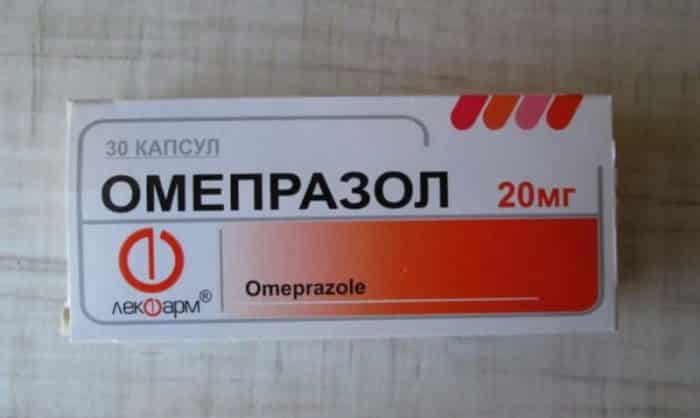
The compatibility of these drugs is beyond doubt; moreover, if you take Omeprazole and De-Nol during the same course of treatment, the drugs will enhance each other’s effects. When using drugs together, the following therapeutic effect is observed:
- Destroying the infection. Taking Omeprazole reduces the level of acidity, which, in turn, creates unfavorable conditions for the development of bacteria. De-Nol limits the mobility of pathogenic microorganisms, preventing their penetration into the walls of the stomach.
Advice! To more completely and effectively destroy the infection, antibiotics are prescribed simultaneously with Omeprazole and De-Nol.
- Additional protection and stimulation of regeneration. Omeprazole reduces the production of hydrochloric acid, which adversely affects the walls of the stomach, and De-Nol creates a protective film under which existing damage heals faster.
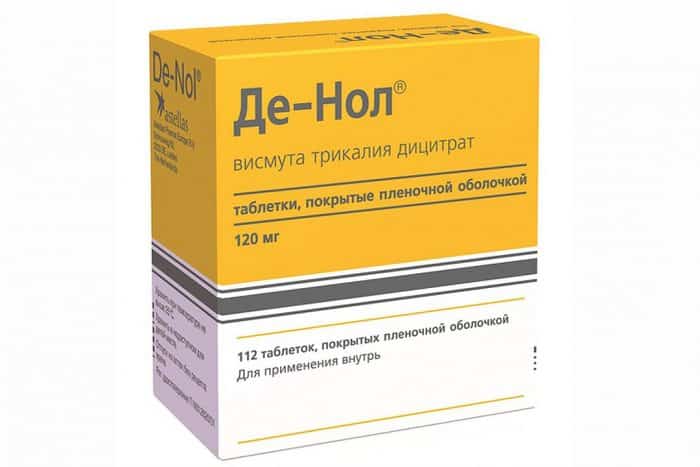
However, you need to know how to take De-Nol and Omeprazole so that the drugs enhance rather than neutralize each other’s effects. The fact is that the protective film that forms when taking bismuth preparations prevents not only the introduction of bacteria, but also the action of drugs. Therefore, taking medications needs to be spaced out over time. As a rule, the following scheme is recommended:
- take Omeprazole in the morning on an empty stomach;
- after 30-40 you can take De-Nol;
- in a quarter of an hour you can have breakfast.
But the doctor may recommend a different dosage regimen. For example, it is sometimes advised to take Omeprazole at night.
Contraindications and side effects
There are several categories of patients for whom the use of both drugs is contraindicated:
- pregnant and lactating women;
- people with individual intolerance to components;
- patients with kidney and liver diseases.
Side effects for those taking Controloc sometimes include headaches and diarrhea. While taking De-Nol, people sometimes complain of an allergic rash. From the gastrointestinal tract there may be nausea, constipation or diarrhea, vomiting.
Comparison of drugs De-Nol and Omeprazole
Let's compare the described medications, assessing their therapeutic effect, release form, composition and contraindications for use.
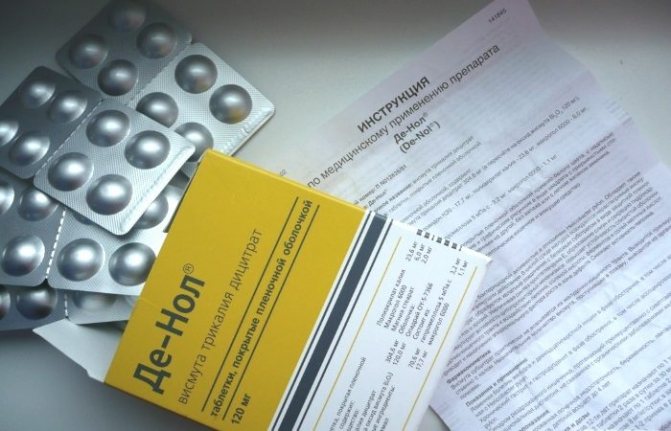
pharmachologic effect
Omeprazole is an antisecretory drug, so the drug is widely used to treat gastritis with high acidity and ulcerative lesions of the digestive tract.
The pharmacological action is based on the suppression of hydrochloric acid synthesis. The active substance of the drug penetrates the cells that produce digestive juices. Accumulating in these cells, the drug regulates the production of caustic substances. Characteristics of the drug:
- the action begins within an hour after administration;
- the effect lasts throughout the day;
- the effect reaches its maximum 4 hours after administration;
- after stopping the medication, secretory activity is restored within a few days.
Advice! Omeprazole acts only within the stomach, but the effect of De-Nol also extends to the intestines.
The main purpose of De-Nol is to protect the walls of the digestive organs, stop the development of erosions and ulcers, and also stimulate faster healing of damage.
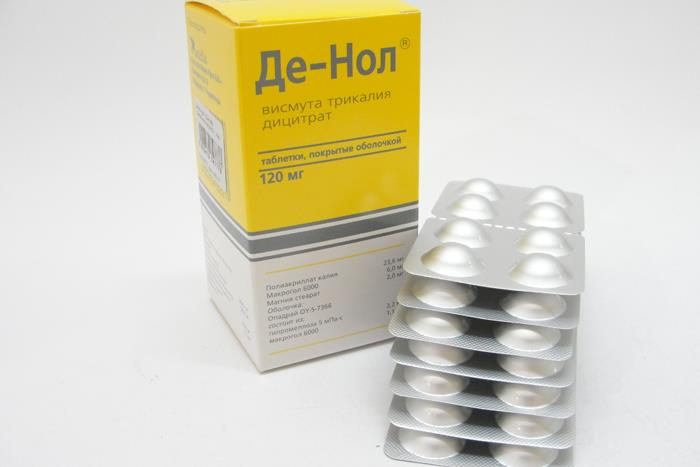
Active ingredient
Each product has its own active ingredient. In De-Nol it is a complex salt of bismuth, and in Omeprazole the active substance bears the name of the drug and is a complex organic compound.
Release form
De-Nol is available in tablet form, Omeprazole - in capsule form. Both drugs are recommended to be swallowed without chewing.
Contraindications and side effects
Contraindications for treatment with De-Nol and Omeprazole are similar. The following drugs should not be taken:
- pregnant women;
- nursing;
- if there is intolerance to the active substance or another component of the product.
Side effects are rare and the medications are generally well tolerated.
Drug treatment
The gastroenterologist determines the form of the patient’s disease, associated pathologies and prescribes medications. Depending on the severity, it can be outpatient or inpatient. In acute cases, bed rest is required.
To eliminate corticovisceral disorders, adaptogens and sedatives are used.
To normalize the acid balance in the stomach, stimulants are prescribed.
Most often, doctors prescribe drugs such as De-Nol, Omez, Creon, Nolpaza, Trimedat, Omeprazole, as well as antibiotics.
Medicines are prescribed depending on the patient’s condition and medical history. They can be divided into groups:
- Antacids.
- H2 – histamine blockers.
- Proton pump inhibitors.
- Cytoprotectors.
- Prokinetics.
- Anti-Helicobacter therapy.
Antacids are taken for high acidity. They relieve pain and fight heartburn. For example, Almagel, Maalox, Simethicone. These medications are taken for two weeks during the acute period.
Histamine blockers are used for superficial gastroduodenitis. It is usually associated with increased stomach acid. For this form of the disease, Ranitidine and Famotidine are prescribed. Children over 12 years old – Famotidine 20 mg twice a day. Ranitidine - 300 mg per dose twice.
Treatment of gastroduodenitis with tablets takes a long time. You cannot suddenly stop taking medications. The dose should be reduced gradually.
For high acidity, drugs from different groups are used. Creon and Nolpaza help relieve pain at the initial stage of the disease. Prescribe diet, antibiotics and vitamins.
Patients are prescribed histamine blockers - Omez, Omeprazole. They reduce acid secretion. Nolpaza blocks the synthesis of hydrochloric acid.
For erosive gastroduodenitis, the combination drug Sucralfate is used. After taking it, a film is formed on the diseased gastric mucosa, which protects the organ from acidic contents. Duration of exposure – 6 hours.
Pharmacological action of drugs in pairs
De-nol and Omeprazole contain different active ingredients that have different effects on the functioning of the stomach. When used together, the following effects are observed:
- Suppression of Helicobacter pylori activity. Omeprazole reduces the acidity of gastric contents, creating conditions unfavorable for the development of bacteria. De-nol inhibits the proliferation of the microorganism and prevents its penetration into the gastric mucosa. With the bolus of food, bacteria penetrate the intestines, from where they are excreted in the feces.
- Protection and healing of the gastric mucosa. A bismuth-based product forms a protective film and starts the cell restoration process. Omeprazole reduces the amount of hydrochloric acid produced, reducing the aggressiveness of gastric juice.
- Improved digestion. Medicines eliminate inflammatory processes, normalizing food digestion.
If a gastroenterologist has recommended taking medications together, you should not refuse treatment. Complex therapy provides effective protection of the gastric walls and accelerates the healing of duodenal ulcers.
2Pharmacological action of drugs in pairs
The drug Omeprazole contains the active ingredient of the same name, and De-Nol contains bismuth tripotassium dicitrate. The drugs are indicated for patients whose diseases are associated with increased acidity of gastric juice. Both medications help eliminate Helicobacter pylori, stop inflammatory processes in the digestive tract, and restore ulcerated defects by regenerating the mucosa. They normalize the level of hydrochloric acid production and reduce its irritating effect on the gastrointestinal tract.
